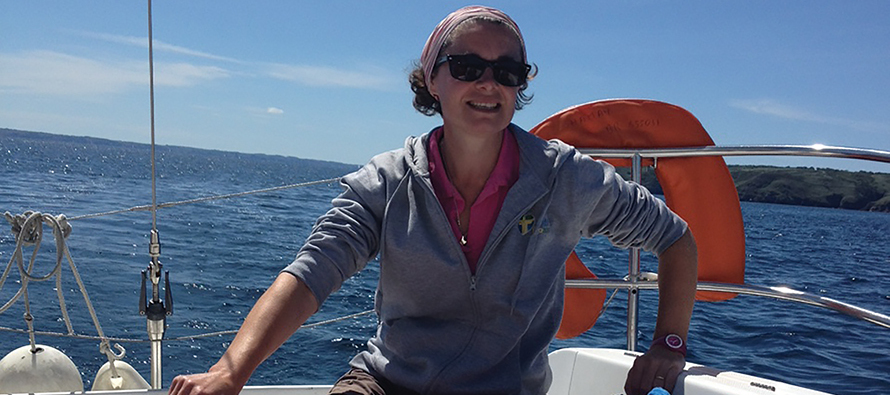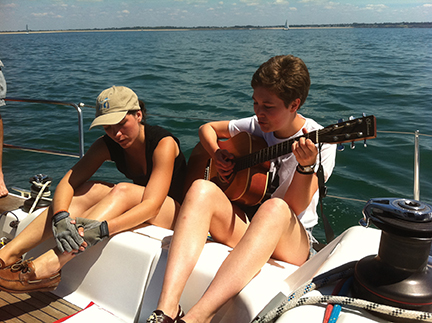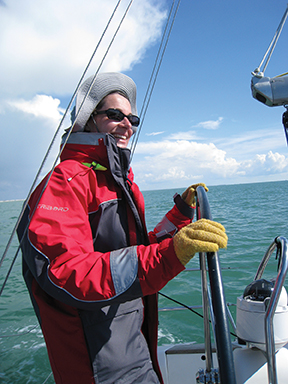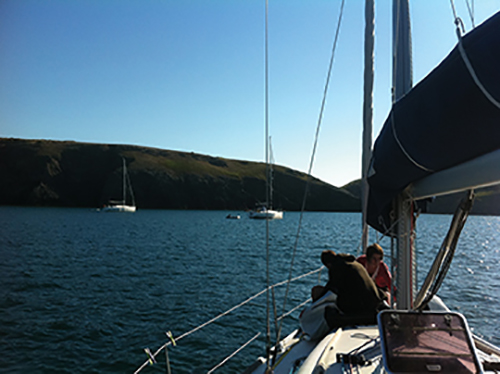Navigating the right course

Image: Sister Nathalie Becquart, Xav. at the helm. A skipper stays on course by paying attention to the boat, wind, and water. In vocation discernment, it is important to pay attention to the currents in one’s inner life.
As a young girl I had the opportunity to spend my holidays by the sea, where I learned to sail. Eventually I became a skipper, and I participated in many regattas, discovering the best way to set my sails and choose the right strategy for the winds and currents. Then I entered religious life, thinking I’d never sail again. But I was fortunate to return to sailing as a mission within religious life when I began organizing retreat cruises for young adults based on the Spiritual Exercises of Saint Ignatius that join learning to sail and life as a crew member with learning to pray, thoughtful reflection, and discernment.
These “Life at Sea” cruises (VieEnMer.org) sail around France in the Atlantic and Mediterranean from February to April for one to two weeks. Each boat is crewed by six teammates and led by a skipper and spiritual guide. During the trip, there is prayer alone and as a group, sharing time, Masses, meditation on scripture, and spiritual direction.

The adventure helps participants take stock of their lives. The sea invites them to reflect on their faith. The change of environment and loss of landmarks is conducive to a personal encounter with God.
This sailing experience has taught me a lot, too, and has helped me to navigate daily in my mission, discern and choose the best course, and steer the projects and teams for which I am responsible. But even more, those long hours spent at sea with changing weather conditions and enriching teammates have given me a language with which to express and share a lifestyle that might entice others—like you!—to come on board.
Lessons from the sea
Being in a moving space with constraints is a reality school. The sea is a place of remarkable freedom because, well-skippered, a boat can go just about anywhere, particularly when the human, technical, and natural elements are all in sync.
Of course, navigation decisions must be made with a destination in mind. And the sailor must learn to adapt to weather and conditions that she cannot control. Failure to take the endeavour seriously risks catastrophe.
When I have to make an important decision, find the way to stay on course through difficulties, or live more fully in the life of the Spirit, I rely on my experiences at sea navigating as a crew member and feeling for the wind to get ahead, full sail.

Take the helm
The helm is the most important connection to the boat. The person at the helm has to be ready to head to sea the moment the boat is unmoored and stay at the helm until the boat reaches the right port.
Being at the helm is a big responsibility. Whether I ask to take the helm or it’s offered to me, it requires taking the lead. It’s always a risk, but a calculated one, done with others you trust. The helm is the center of all the other relationships on the boat, an exchange-of-information point, which requires a lot of attention and concentration. To be a good helmsperson, I have to listen attentively to the boat and the crew, understand their reactions and be able to respond correctly. To steer a course I have to feel the tiller go with my desired direction or against it. If the waves make us veer off, I have to adjust.
When wind, currents, or waves kick up, steering becomes more difficult. Helming requires stabilizing the boat in its movement, so it can make headway with equilibrium in the middle of the water’s motion. The helmsperson’s steering technique is evident in the boat’s wake.
The good helmsperson knows how to steer smoothly, without abrupt movements. She’s always alert because she has to anticipate. She’s in tune with the crew, the environment, and the boat. The bad helmsperson, on the other hand, makes big tiller movements, causing the boat to knock into the waves.
God’s Spirit leads us to steer our lives softly, like a good helmsperson. It requires a lot of learning and practice. I work hard to prevent myself from just drifting along. I try to decide on and follow a realistic course, taking into consideration the many variables in my life. My life leaves a wake, and I can see from that if I’m helming the way I should be. Moments of joy and peace when I have let myself be driven by the wind of the Spirit tell me I am on course. But when I’m feeling dragged down or stuck in a constraining circle, I know I have let myself be taken by bad currents and it is time to change course.

Find your way
Even the best helming, though, is subject to unpredictable conditions, from violent storms to dead calms. Sailors must learn to be patient with the fickleness of the wind. Sometimes you just have to wait, hold on, stay firm, and hope. Arrival on shore is a relief akin to resurrection.
Until we experience our boats in all conditions, we don’t really know it. We must travel many, many miles to gain the necessary experience to go further still.
Alternating storms and dead calms are also what we experience in our spiritual lives—difficult moments, marked by restlessness, where we have to hold on and stay firm, and moments of dead calm, marked by doubt or spiritual drynees, where we must patiently wait.
Shifting feelings of distress and comfort are what Ignatius of Loyola experienced after being wounded in the battle of Pamplona. By paying attention to his states of sadness and joy, he discovered what is grounded in vanity and what in holiness, and he chose to follow his deepest desire—the path of holiness.
There is no other way to discover one’s deepest desires—the thing that will bring us true joy—than to identify our interior movements— the different currents that reside in us—and be attentive to the effects they have on us.
Navigating in this way, I discover who I am, how I react in different circumstances, and how God guides me toward my heart’s desire.
Related article: vocationnetwork.org, “How to wait for clarity about your vocation,” Vision 2014.
Tags
Related
- Questions Catholics Ask: What are the different forms of prayer?
- What does “success” look like in discernment?
- How to find a guide for your vocation adventure
- Beware of bots and bad actors as you engage online
- Call stories to help you discern
- Five reasons to pray the Liturgy of the Hours
- Tune into your prayer life
- Embody your decisions
- Your mission awaits you! Pope Francis' message to young people
- My portable prayer life Read More
Most Viewed
- Find your spirituality type quiz
- Questions and answers about religious vocations
- Celibacy quiz: Could I be a nun? Could I be a brother? Could I be a priest?
- Resources for older discerners or those with physical and developmental differences
- About Vocation Network and VISION Guide


